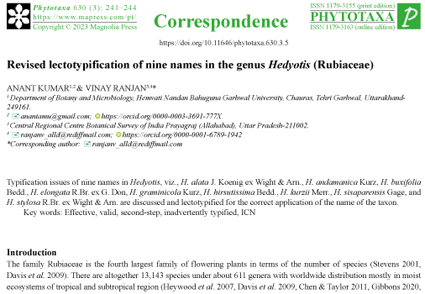Abstract
N/A
References
- Beddome, R.H. (1864) Contributions to the Botany of Southern India. Madras Journal of Literature and Science, series 3, 1: 37–59.
- Bremekamp, C.E.B. (1952) Verhandelingen der Koninklijke Nederlandsche Akademie van Wetenschappen. Afdeeling Natuurkunde, Sectie 2. Vol. 48 (2). Amsterdam, pp. 113.
- Champion, J.G. & Bentham, G. (1852) Hooker’s Journal of Botany and Kew Garden Miscellany. Vol. 4. London, pp. 171. [https://core.ac.uk/download/pdf/4510385.pdf]
- Chen, T. & Taylor, C.M. (2011) Hedyotis. In: Wu, Z.Y. & Raven, P. (Ed.) Flora of China, vol. 19. Science Press; Missouri Botanical Garden Press, pp. 147–174.
- Davis, A.P., Rafael, G., Bridson, D.M., Ruhsam, M., Moat, J. & Brummitt, N.A. (2009) A Global Assessment of Distribution, Diversity, Endemism, and Taxonomic Effort in the Rubiaceae. Annals of the Missouri Botanical Garden 96: 68–78. https://doi.org/10.3417/2006205
- De Candolle, A.P. (1830) Prodromus systematis naturalis regni vegetabilis, vol. 4. Treuttel & Würtz, Paris, pp. 422.
- Deb, D.B. & Dutta, R. (1985) Further Nomenclatural Changes in Hedyotis (Rubiaceae) of South Asia. Taxon 34 (2): 296–297. https://doi.org/10.2307/1221797
- Don, G. (1834) A general history of the dichlamydeous plants: comprising complete descriptions of the different orders, vol. 3. Rivington, London, 867 pp.
- Dutta, R. & Deb, D.B. (2004) Taxonomic revision of Hedyotis L. (Rubiaceae) in Indian Subcontinent. Botanical Survey of India, Kolkata, 219 pp.
- Gage, A.T. (1906) Hedyotis sisaparensis, a hitherto undescribed Indian species. Journal and Proceedings of the Asiatic Society of Bengal, Calcutta 1: 244.
- Gibbons, K.L. (2020) Hedyotis, Oldenlandia and related genera (Rubiaceae: Spermacoceae) in Australia: New genera and new combinations in an Asian-Australian-Pacific lineage. Taxon 69 (3): 515–542. https://doi.org/10.1002/tax.12236
- Heywood, V.H., Brummitt, R.K., Culham, A. & Seberg, O. (2007) Flowering plant families of the world. Richmond, Kew, 424 pp.
- Hooker, J.D. (1880) Hedyotis. In: Hooker, J.D. (Ed.) Flora of British India. vol. 3. L. Reeve & Co., London, pp. 49–64.
- Kurz, S. (1872) New Burmese Plants (Part First). Journal of the Asiatic Society of Bengal. Part 2. Natural History, Calcutta 41 (4): 291–318.
- Kurz, S. (1875) Descriptions of new plants from the Nicobar Islands (including a few from the Andaman Islands). Journal of Botany 13: 321–333.
- Kurz, S. (1876) A Sketch of the Vegetation of the Nicobar Islands. Journal of the Asiatic Society of Bengal. Part 2. Natural History, Calcutta 45 (3): 105–164.
- Linnaeus, C. (1753) Species plantarum. Laurentii Salvii, Holmiae (Stockholm), 1200 pp.
- Merrill, E.D. (1934) New Sumatran Plants I. Papers of the Michigan Academy of Science, Arts and Letters 19: 149–203.
- Murugan, P., Kottaimuthu, R. & Murugan, C. (2022) Typification of thirty-five names in Rubiaceae of the Southern Western Ghats, India. Garden Bulletin Singapore 74 (2): 257–274. https://doi.org/10.26492/gbs74(2).2022-11
- Neupane, S., Dessein, S., Wikström, N., Lewis, P.O., Long, C., Bremer, B. & Motley, T.J. (2015) The Hedyotis-Oldenlandia complex (Rubiaceae: Spermacoceae) in Asia and the Pacific: Phylogeny revisited with new generic delimitations. Taxon 64 (2): 299–322. https://doi.org/10.12705/642.8
- POWO (2023) Plants of the World Online. Facilitated by the Royal Botanic Gardens, Kew. Available from: http://www. plantsoftheworldonline.org/ (accessed: 3 April 2023).
- Stevens, P.F. (2001 onwards) Angiosperm Phylogeny Website. Version 9, June 2008. Available from: http://www.mobot.org/MOBOT/research/APweb/ (accessed: 19 December 2023).
- Thiers, B. (2023 Continuously updated) Index Herbariorum: A Global Directory of Public Herbaria and Associated Staff. New York Botanical Garden’s Virtual Herbarium. Available from: http://sweetgum.nybg.org/science/ih/ (accessed: 3 April 2023). https://doi.org/10.1007/s12228-016-9423-7
- Turland, N.J., Wiersema, J.H., Barrie, F.R., Greuter, W., Hawksworth, D.L., Herendeen, P.S., Knapp, S., Kusber, W.-H., Li, D.-Z., Marhold, K., May, T.W., McNeill, J., Monro, A.M., Prado, J., Price, M.J. & Smith, G.F. (Eds.) (2018) International Code of Nomenclature for algae, fungi, and plants (Shenzhen Code) adopted by the Nineteenth International Botanical Congress Shenzhen, China, July 2017. Regnum Vegetabile 159. Glashütten: Koeltz Botanical Books. https://doi.org/10.12705/Code.2018
- Wallich, N. (1829[as 1828]–1849) A numerical list of dried specimens of plants in the East India Company’s Museum, collected under the superintendence of Dr. Wallich of the Company’s Botanic Garden at Calcutta. London. [https://wallich.rbge.info/node/16622]
- Walpers, G.G. (W.G.) (1843) Repertorium botanices systematicae. Tomus 2, Supplementum 1. Hofmeister, Lipsiae, 1029 pp. https://doi.org/10.5962/bhl.title.7553
- Wight, R. & Arnott, G.A.W. (1834) Prodromus Florae Peninsulae Indiae Orientalis: containing abridged descriptions of the plants found in the peninsula of British India, arranged according to the natural system, vol. 1. Parbury, Allen & Co., London, 480 pp. https://doi.org/10.5962/bhl.title.252


